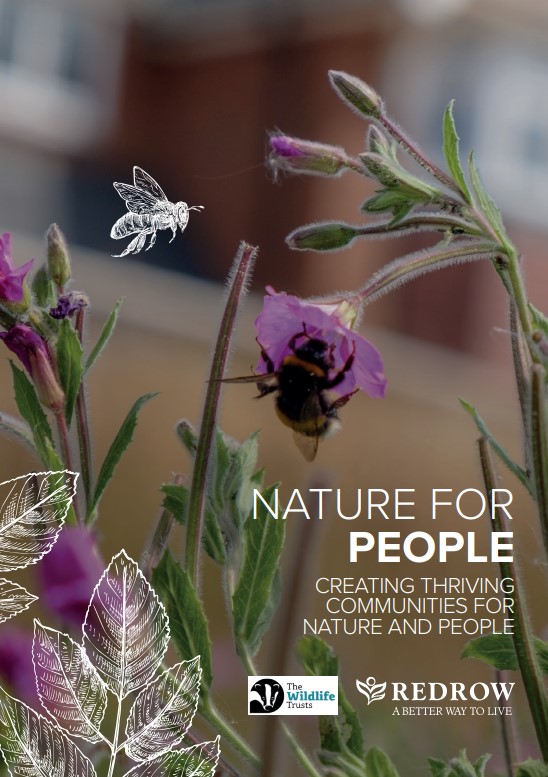

Enhancing biodiversity on our developments is key to our placemaking approach, tackling the nature and climate crises, and supporting resident’s wellbeing.
Our Strategy to Protect and Enhance Biodiversity
Our biodiversity strategy, ‘Nature for People’, was developed in partnership with the Wildlife Trusts in 2020. It contains 15 commitments across three themes: nature gains, wilder lives and a flourishing legacy.
In addition to seeking to achieve net gains for biodiversity on our developments, the strategy also considers the wider landscape impacts of our developments, locally appropriate planting, and creating green spaces and water features that are connected and multi-functional. It also considers how we can best help the community to enjoy and care for the nature-rich green spaces, along with how we’ll report on outcomes for people and nature.
We worked in partnership with the Wildlife Trusts to develop our strategy for enhancing nature on our developments. Find out about our vision, approach and commitments to enhancing nature on our developments to ensure it thrives for the long-term.Our strategy goes beyond Biodiversity Net Gain


Our Biodiversity Net Gain Target
We have set a target to demonstrate a minimum 10% net gain for biodiversity on every new planning application by November 2023. Our aim is to prioritise delivery of these gains on site to bring nature onto our developments, improve climate resilience and benefit local people.
We know that on-site gains of 10% using the Defra metric 3.1 will not always be possible due to site constraints and other requirements, and that a well-considered offsetting strategy can deliver important biodiversity objectives. We are currently learning from our experience of BNG across a number of different development types and local authorities, which will inform our future approach.

Tackling Biodiversity and Climate Change Together
Climate change and biodiversity are closely inter-connected: Climate change is one of the main drivers of biodiversity loss, and at the same time, the destruction of ecosystems undermines nature’s ability to regulate greenhouse gas emissions and protect against extreme weather, thus accelerating climate change.
Our Nature for People strategy supports carbon reduction and resilience to a changing climate by providing biodiverse green spaces, increasing vegetation and shading from trees to provide cooling, and employing nature-based solutions for water attenuation. Visit our climate change strategy page for more information.

Our progress FY2022
- • New land purchase policy in place to assess BNG for all new developments
• Updated Land, Planning and Technical policies and procedures to include BNG and nature requirements
• Development of new Redrow Biodiversity Net Gain manual
• Forum engaging with ecological consultants on BNG in place
• Training to all teams on BNG
• New monthly Biodiversity Bites sessions learning and sharing best practice on BNG
• New Group ecology expertise in place
• Our Ponds Working Group is developing a framework for delivering beautiful, landscape-led, biodiversity-rich ponds as standard
Creating a Wildflower Meadow
The foundation of our approach is to retain and enhance existing habitats and natural features of high nature value. We also have the opportunity to create new habitats on our developments which can support a range of wildlife as well as amenity for residents. We are moving away from closely manicured grass and heavily engineered drainage system to more natural features that provide greater biodiversity value. We’ve been providing new standards for teams on the creation and maintenance of new meadows.
Case studies

Creating a buzz for nature
At Saxon Brook in Devon, we have created the UK’s first ever pollinator-friendly housing development, with support from the Bumblebee Conservation Trust (BBCT). The development achieves this through large areas of wildflowers, an orchard and bee-friendly planting throughout.

PROTECTING BATS
Mill Meadows in South Wales is a former paper mill that was home to three species of bats. A bespoke bat house was designed and built with various ‘rooms’ to accommodate the different species. We are delighted that endangered lesser horseshoe bats are now breeding at the site for the very first time.

64% increase in biodiversity
At our Caddington Woods development, Chaul End, we worked with both the RSPB and Bumblebee Conservation Trust to ensure we protect and enhance existing species as well as creating new habitats to increase wildlife on the development, resulting in a 64% net gain for biodiversity.

REVERSING THE DECLINE OF GREAT CRESTED NEWTS
We have transformed the derelict site of a former clay-pit and brickworks in Buckley, Flintshire into a thriving new community along with 45 new ponds for newts and other wildlife. Latest surveys show an 85% occupancy rate in the newly created ponds, with a Welsh record peak count of 1,173, smashing the KPI target of 600 adults counted across the wider survey areas.







